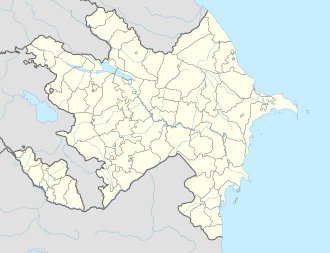Top Qs
Timeline
Chat
Perspective
Tugh (village)
Place in Khojavend, Azerbaijan From Wikipedia, the free encyclopedia
Remove ads
Tugh (Azerbaijani: Tuğ) or Togh (Armenian: Տող) is a village in the Khojavend District of Azerbaijan, in the region of Nagorno-Karabakh. The village had a mixed Armenian-Azerbaijani population before the First Nagorno-Karabakh War, the Azerbaijani inhabitants fled the fighting in 1991,[2] and the Armenian population fled the village during the 2020 Nagorno-Karabakh war.
Remove ads
History
Summarize
Perspective


The village and the neighboring fortress of Ktish (Armenian: Քթիշ) are first mentioned in the 9th century, as the capital of the Principality of Dizak.[3] In 854, Esayi Abu-Muse, the Prince of Dizak, resisted an Abbasid army under the command of Bugha al-Kabir at Ktish for more than a year.[4] Ktish began to be called Togh starting in the 15th century.[4]
The 13th-century monastery of Gtichavank, and ruins of some churches including the 13th-century St. Stepan Church are located near the village. The village church is named St. Hovhannes (John's) and was built in 1736. A few of the Yeganyan meliks are buried in the yard of St. Hovhannes Church.[3]
In 1737, Armenian prince (melik) Yegan built Togh's Melikian Palace here. The principality survived until the last prince, Yesayi Melik-Avanian, was killed by Ibrahim Khalil Khan in 1781, after a long-lasting resistance in the fortress of Ktish. The village was a part of the Karabakh Khanate until 1822, when it was annexed by Russia and became part of the Elisabethpol Governorate.
In 1903, a hospital was built and three years later a village school was opened which has functioned as a middle school in the present-day.[3] A new school was built in 1978, which was renovated for the first time in 2008 by the Armenia Fund.[5] The village also has a house of culture, a movie theater and a library.[3]
During the Soviet period, the village was part of the Hadrut District of the Nagorno-Karabakh Autonomous Oblast.
During the First Nagorno-Karabakh War, in March 1988, Armenian armed militia detachments were formed to defend the village from Soviet and Azerbaijani attacks.[3] The village came under Armenian control on 30 October 1991.[6] As a result of the war, local Azerbaijani villagers were forced to flee and many settled in the Beylagan District of Azerbaijan. After the First Nagorno-Karabakh War, the village was administrated as part of the Hadrut Province of the breakaway Republic of Artsakh.[3]
The village's Armenian population was displaced due to its capture by Azerbaijan on 9 October 2020, during the 2020 Nagorno-Karabakh war.[7] The Artsakh Human Rights Ombudsman stated that there were reports of two civilians that had been killed, with one of them having been beheaded.[8][9]
Remove ads
Historical heritage sites
Historical heritage sites in and around the village include the fortress of Ktish (Armenian: Քթիշ, also Ktishberd, Քթիշբերդ) from between the 9th and 13th centuries, a 12th/13th-century khachkar, the monastery of Gtichavank (Armenian: Գտչավանք) built between 1241 and 1246, a cemetery from between the 17th and 19th centuries, St. John's Church (Armenian: Սուրբ Հովհաննես եկեղեցի, romanized: Surb Hovhannes Yekeghetsi) built in 1736, Togh's Melikian Palace (Armenian: Տողի մելիքական ապարանք, romanized: Toghi Melikakan Aparank) built in 1737, and St. Stephen's Church (Armenian: Սուրբ Ստեփանոս եկեղեցի, romanized: Surb Stepanos Yekeghetsi) built in 1747.[1]
Remove ads
Economy and culture
In 2015, the population was mainly engaged in agriculture and animal husbandry, and the village had a municipal building, a house of culture, a secondary school, a kindergarten, an art school, and a medical centre.[1] The Kataro winery was opened by the Avetisyan family in 2010 in the village.[10][11]
Demographics
According to the Russian Empire census in 1897, where the village was mentioned as Tug (Russian: Тугъ), it had a population of 1,728 consisting of 1,482 Armenian Apostolics and 246 Muslims. The village had 857 men and 871 women.[12]
In 1921, the village had 1,589 Armenian inhabitants.[13] In 1974, there were 1,228 inhabitants,[3] and in 1987 there were 1,421 inhabitants.[3]
The Azerbaijani inhabitants of the village, as well as the inhabitants of the village of Salaketin in the Hadrut District, were forced to flee their homes as a result of Armenian armed formations' hostilities during the First Nagorno-Karabakh War.[2]
In 2005, the village had an Armenian-majority population of 679 inhabitants,[14] and in 2015 there were 756 inhabitants.[1]
Remove ads
Gallery
- 18th-century St. John's Church
- Buildings of Togh's Melikian Palace
- 18th-century St. Stephen's Church
- WWII monument
- Third Annual Artsakh wine festival in the village
- Exhibition of artworks at the Artsakh wine festival in the village
Notable people
- Javad Malik-Yeganov - Azerbaijani Governor-General of Lankaran
- Aslan Mukhtarov - Azerbaijani scientist, recipient of the USSR State Prize.[15]
- Ayriev Armen Tevanovich - Armenian Hero of the Soviet Union
- Vigen S. Grigoryan - Armenian battalion commander during the First Nagorno-Karabakh War
References
External links
Wikiwand - on
Seamless Wikipedia browsing. On steroids.
Remove ads









